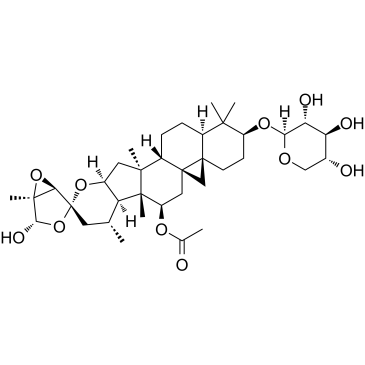Pregnane X receptor-mediated induction of Cyp3a by black cohosh.
Xiaoyan Pang, Jie Cheng, Kristopher W Krausz, De-an Guo, Frank J Gonzalez
Index: Xenobiotica 41(2) , 112-23, (2011)
Full Text: HTML
Abstract
Black cohosh (BC) has been widely applied for the treatment of menopausal symptoms. However, increasing concerns about herb-drug interactions demand the need for studies on the influence of BC on cytochrome 450. Cyp3a11 in liver was induced by 7-fold in wild-type mice treated with 500 mg/kg black cohosh for 28 days compared with the control group as assessed by quantitative real-time PCR; no difference was found in small intestine and kidney, suggesting that up-regulation of Cyp3a11 by black cohosh was liver-specific. Western blot, activity assays, and pharmacokinetic analyses established dose- and time-dependent induction of Cyp3a11. To determine the mechanism of Cyp3a11 induction, including the role of pregnane X receptor (PXR) in vivo and in vitro, respectively, in Pxr-null, PXR-humanized, and double transgenic CYP3A4/hPXR mice, cell-based luciferase assays were employed revealing that mouse PXR played a direct role in the induction of Cyp3a11; human PXR was not activated by black cohosh. Overall, these findings demonstrate that induction of Cyp3a11 is liver-specific and involved only mouse PXR, not the human counterpart. Thus, the incidence of herb-drug interaction in patients administered black cohosh may not be mediated by human PXR and CYP3A4.
Related Compounds
| Structure | Name/CAS No. | Molecular Formula | Articles |
|---|---|---|---|
 |
Actein
CAS:18642-44-9 |
C37H56O11 |
|
Bioactivity-guided isolation of GABA(A) receptor modulating ...
2010-12-27 [J. Nat. Prod. 73(12) , 2024-8, (2010)] |
|
Growth inhibitory activity of extracts and compounds from Ci...
2008-06-01 [Phytomedicine 15(6-7) , 504-11, (2008)] |
|
Studies on the Chinese crude drug "shoma." IX. Three novel c...
1995-05-01 [Chem. Pharm. Bull. 43(5) , 771-6, (1995)] |
|
Actein and a fraction of black cohosh potentiate antiprolife...
2006-10-01 [Planta Med. 72(13) , 1200-6, (2006)] |
|
Anti-AIDS agents. Part 57: Actein, an anti-HIV principle fro...
2004-03-08 [Bioorg. Med. Chem. Lett. 14(5) , 1329-32, (2004)] |